Table of Contents
The number of confirmed global deaths due to COVID-19 is almost 4.2 million, as of July 2021 report on Statista. By comparison, the last Great Plague of 1665 killed a million people. This number of fatalities due to the novel coronavirus is a staggering figure, especially considering that we are in an age of revolutionary medical discoveries and technology.
Since the 2019 discovery of SARS-CoV-2 or COVID-19 in China, scientists have successfully identified the novel virus. At present, several countries have also developed the COVID-19 vaccine, and mass vaccinations are ongoing.
However, the detection of the COVID-19 virus was critical to making this happen. It was the pathway that led to the eventual development of the vaccine as well. In the beginning, scientists used a combination of whole-genome sequencing, computed tomography imaging, electron microscopy, and other diagnostic tools to identify SARS-CoV-2.
PCR, short for a polymerase chain reaction, is one of the popular methods that help identify the COVID-19 virus. This post breaks down the science behind this method of identifying the novel coronavirus and identifies the best PCR thermal cyclers on the market.
What is PCR Thermal Cyclers?
PCR Thermal Cyclers are important laboratory apparatus for researchers and scientists. It amplifies or copies the RNA/ DNA strands in the samples. In addition, the thermal cycler can also raise and lower the temperature necessary to run the three stages in a polymerase chain reaction.
Other names of a PCR thermal cycler include PCR machine, thermocycler, and DNA amplifier.
The primary fields where PCR thermal cyclers are indispensable are:
- Immunology
- Oncology
- Human genome project
- Population biology
- Researches in zoology and botany
- Forensics
- Paleontology
- Hereditary disease and tumor
- Clinical diagnosis of viruses
PCR thermal cyclers allow scientists and researchers to make millions of copies of a specific section of DNA and RNA from the smallest sample. For DNA and RNA sequencing, PCR makes it easy to detect the absence or presence of genes to identify pathogens.
The first commercial thermal cycler, TC1 DNA, hit the market in 1987. The first thermal cycler was rather basic, although it could heat and cool samples with a metal block. However, modern PCR thermal cyclers have come a long way with significant advancements in technology and functions.
Some of the best PCR thermal cyclers on the market come with precise temperature control and multiple block formats. In addition, you can also run two independent experiments simultaneously, which increases the output in a significant manner.
At present, there are many types of thermal cycles pcr, each with different features – from personal to mini thermal cyclers that easily fit on a desk to larger ones. In addition, you can also interlink several thermal cyclers to form a larger PCR system, especially in extensive projects. A large PCR system can also be easily hooked up to a central computer for automation and control.
How is the COVID-19 virus detected using PCR thermal cyclers?
Between the three tests employed to detect SARS-CoV-2, PCR is considered the most reliable with the results. COVID-19 results from PCR testing are also the most accurate for active coronavirus infection.
The section below details how PCR thermal cyclers detect the SARS-CoV-2 virus.
Sample collection
The steps in detecting the SARS-CoV-2 virus begin with collecting samples from a host, usually humans. Typically, sample collectors employ two types of swabs for COVID testing.
First is the nasal swab that collects the sample from the nostrils and the periphery. The second is the nasopharyngeal swabs, where the flexible sample collection tip goes into the nasal cavity.
In some cases, COVID swabs are also collected from the throat. But it is not as common as nasal swabs. For scientific research purposes, the collection of stool, serum, and ocular secretions are not uncommon.
In addition, some laboratories also rely on self-collected saliva samples. Saliva samples are relatively painless than upper respiratory tract sample collection. This method also enables higher volume testing in labs and lowers the risk of contamination for healthcare providers.
The technician or the medical person that collects the sample seals it in a test tube and sends it to the laboratory for testing.
Extraction
The technician isolates genetic material in the lab – the RNA of the potential virus from the sample. The technician typically treats the sample with chemical solutions to remove substances, including fats and protein.
After the extraction is complete, the RNA from the sample is isolated. This RNA is a mixture of the host’s genetic material and the SARS-CoV-2 virus.
PCR or Polymerase Chain Reaction
Polymerase Chain Reaction is the stage that detects the presence of the SARS-CoV-2 virus in the sample. The isolated RNA is mixed with a special ingredient to start the PCR process, typically enzymes. Special enzymes usually vary according to the different virus that is getting tested.
Therefore, for the SARS-CoV-2 virus, the special enzymes are reverse transcriptase and DNA polymerase. In addition, other ingredients include:
DNA building blocks.
Probes or marker labels.
Cofactors.
Primers that identify and bind easily to the SARS-CoV-2.
Like using a special enzyme to detect the COVID-19 virus, specific probes and primers are also required. According to the CDC, some of the recommended probes and primers for the detection of COVID-19 include:
Forward primers – 2019-nCoV_N1-F, 2019-nCoV_N2-F, RP-F
Reverse primers – 2019-nCoV_N1-R, 2019-nCoV_N2-R, RP-R
Probes – 2019-nCoV_N1-P, 2019-nCoV_N1-P, 2019-nCoV_N2-P, 2019-nCoV_N2-P, RP-P, RP-P
This list of the COVID-19 testing probes and primers is by no means exhaustive or absolute. SARS-CoV-2 is a novel coronavirus – meaning that no known tests about the virus existed before 2020. Besides, the global rates of infection were also exploding without control. This prompted scientists and researchers to develop the primers, probes, and even testing methods for SARS-CoV-2 from scratch and in minimal time.
Therefore, besides using other primers and probes mentioned above, the testing methods may also be tweaked to get the most accurate result for detecting the COVID-19 virus. Furthermore, primers and probes for testing coronavirus samples also vary from one country to the other.
Visit this link for a full list of primers and probes used in other countries, including Germany, Japan, and China.
Note: Combining the RNA with these ingredients is essential as it converts the RNA into DNA. Conversion of isolated SARS-CoV-2 RNA into DNA copy is a vital process since PCR only works for DNA.
Along with the enzymes, the DNA copy of the SARS-CoV-2 is forced apart into short primers with high heat. Simultaneously, these short complementary DNA primer templates come and stick together, forming the base site for DNA synthesis. As the DNA continues to join together, the short primers start extending to form a copy of the SARS-CoV-2 DNA.
Furthermore, the second primer also forms on the opposite orientation of the first primer. This results in the formation of a SARS-CoV-2 DNA copy that is complementary to the original strand. The next round of heating produces further copies of the SARS-CoV-2 DNA strands, and the cycle is repeated until enough copies of COVID-19 DNA copies are amplified.
Regardless of whether the extracted RNA is a COVID-19 virus sample or not, the principle of the polymerase chain reaction is the same and involves three stages. These are denaturing, annealing, and extending.
Many important processes occur during the three stages of PCR that are detailed in the following section.
Denaturing
It is the first stage of the process of polymerase chain reaction. Here, the isolated SARS-CoV-2 RNA is mixed with the special enzymes and other ingredients.
This cocktail is put inside a PRC thermal cycler that heats up to 95oC or 203oF. The combination of extremely high temperature and the special enzymes separates the hydrogen bonds between the two strands of the SARS-CoV-2 DNA base template.
This separation of the SARS-CoV-2 DNA into two strands forms the DNA templates where the production of new COVID-19 strands will occur. The whole process of DNA strand separation completes in about 15 to 30 seconds. However, maintaining a constant 94 to 95oC temperature is critical for the successful completion of denaturing.
In this regard, using a PCR thermal cycler that is great in quality is vital. Substandard thermal cyclers PCR will not have the features or the capacity to withstand extremely high temperatures.
Annealing
The second stage is annealing, where the high temperature is cooled down to about 50 to 65oC or 122 to 149oF. As the cooling occurs, the primers and probes start binding to complementary sections, forming template DNA strands through hydrogen bonding. This binding process results in the formation of two-stranded DNA. It also allows the DNA polymerase to form the complementary strands from the loose base templates or the building blocks.
In detecting the SARS-CoV-2 virus, DNA polymerase, one of the special enzymes, begins assembling the new strands from the template DNA strands. The newly formed DNA strands run in opposite directions, thereby forming the forward and the reverse primer. In addition, the new strands are also complementary, which allows the amplification of the viral DNA.
A standard PCR thermal cycler doubles the DNA copies of the numbers. So one cycle makes two DNA copies, and the second cycle makes four copies, etc. Most PCR thermal cyclers can run up to 35 cycles, making up to 35 billion DNA copies by the end of all the cycles.
The annealing stage in the detection of the SARS-CoV-2 virus completes in about 10 to 30 seconds.
Extending
Extending is the final stage in the polymerase chain reaction. In the extending stage, the temperature of the PCR thermal cycler is taken up to 72oC or 161oF. It involves the formation of new DNA strands by the addition of bases by an enzyme.
In most cases of virus detection, Taq DNA polymerase is used. This DNA polymerase comes from a bacterium that lives in hot springs and can withstand extremely high temperatures.
The Taq DNA polymerase starts building the new DNA strand by attaching it to the primer. In addition, the polymerase enzyme also starts adding bases to the single DNA strands in both the forward and reverse direction of the primer.
At the end of extending cycle is a new DNA strand complete with the double molecule structure. The duration of the extending stage typically depends on the length of the viral DNA that is undergoing the sequencing. However, a good PCR thermal cycler can generally copy up to 1,000 DNA copies in under a minute.
The lab technician can also tell whether there is SARS-CoV-2 present in the sample or not around the time the DNA copies are available in the PCR thermal cycler. Simultaneously as the cycler makes new copies of DNA, the primers also start copying the targeted sections in the complementary strands.
Furthermore, the probes or marker labels start attaching themselves to the newly formed DNA fragments and visually signals the thermal cycler’s screen. The signal is usually in the form of a fluorescent dye that the cycler can pick up very easily. The PCR thermal cycler’s internal computer measures the frequency and the amount of these visual signals in real-time. Therefore, thermal cyclers are also known as RT-PCR.
The cycler’s internal computer keeps track of the fluorescent dye in each cycle to confirm the SARS-CoV-2 virus in the sample. If fluorescent probes exceed a certain amount, it confirms that the nasal sample contains the SARS-CoV-2 or the COVID-19 virus.
In addition, the scientist or the lab technician monitors the number of cycles required for the probes to reach the limit set in the testing. For each COVID-19 sample, the fewer PCR cycles it takes to reach the level to determine the severity of the coronavirus infection in the COVID-19 positive patient.
On the other hand, if the SARS-CoV-2 virus is not present in the given sample, the probes will not stick to the new DNA fragments. In addition, there will be no visual signal on the thermal cycler’s screen. In this case, the COVID-19 sample is declared SARS-CoV-2 virus-free, and the test is negative.
What is the use of thermal cycler in PCR?
Thermal cyclers PCR or thermocyclers are devices that are an indispensable part of the polymerase chain reaction. The main function of a thermal cycler is to amplify or copy samples of DNA and RNA through a polymerase chain reaction. Thermal cyclers also allow the seamless transition between extremely high and low temperatures vital in the three stages of PCR.
That being, the main uses and features of thermal cycler in PCR are as follows:
Heating and cooling
Thermal cyclers PCR seamlessly heat and cool the DNA or RNA samples. Depending on the brand and the model of the thermal cycler, it can reach a maximum temperature of 95oC or 203oF.
In addition, the lid temperature of thermal cyclers can withstand the extreme heat of up to 105oC or 221oF. The ability of the cycler’s lid to hold such high temperatures prevents the DNA or the RNA sample in the centrifugal tube from evaporating.
The heated lid of a thermal cycler also prevents the condensation of water on the inside of the lids, disturbing the final result of the tests. In the older version of thermal cyclers, mineral oil or paraffin was used for this purpose.
Temperature ramp control
A thermal cycler is also useful for temperature ramp control. Because the machine undergoes extreme heat and cooling differences, the automatic ramp settings easily control the temperature without difficulties.
Some of the best thermal cyclers PCR have a ramp time feature. Ramp time is the duration of time that the machine takes to heat up or cool down to a specific temperature. In addition, you can also program the thermal cycler to run at a specific temperature for the desired cycle and time.
Auto-restart function
In case of power failure during a chain reaction, thermal cyclers can auto-restart easily. The auto-restart feature in a thermal cycle is significant as it allows the machine to restore the data and continue the cycle without interruption. Without this function, PCR testing for COVID-19 samples will not be as quick.
Reliable operation
Thermal cyclers are also equipped with the thermoelectric module as well as thermoelectric cooling. It is due to these features in thermal cyclers that PCR can operate reliably under stable conditions.
The earliest PCR thermal cyclers were not as reliable, which compromises the results of the tests. But the modern thermocyclers on the market are extremely reliable and have become the gold standard for testing the SARS-CoV-2 virus.
Real-time display and function
Thermal cyclers PCR can also monitor the polymerase chain reaction in real-time, allowing researchers to read the test results instantly. This enables the COVID-19 test results to be available within 24 hours of collecting the nasal sample.
In addition, the cycler also inspects execution and the remaining execution time of every cycle in the reaction.
Multiple functions
Some of the best thermal cyclers come with advanced features such as multiple blocks. If a thermal cycler has multiple blocks, researchers can carry out multiple polymerase chain reactions simultaneously.
Furthermore, in some thermal cyclers, there is a gradient feature. With the gradient feature, lab technicians can monitor the difference of temperatures in experiments without interrupting the other.
Advantages of using PCR thermal cyclers for the detection of COVID-19 virus
1. Accurate results
Since discovering the SARS-CoV-2 virus in Dec 2019, PCR Thermocyclers have proven to be the gold standard for detecting the virus. According to a January 2021 study, the accuracy of PCR tests in detecting COVID-19 is as high as 99.7%.
The accuracy of the PCR tests varies slightly depending on whether the sample is sputum, urine, stool, rectal swab, or plasma. Nevertheless, PCR thermal cycler testing for the SARS-CoV-2 virus remains the most accurate test method to date.
2. Quick procedure and fast results
Another outstanding strength of using polymerase chain reaction for testing the SARS-CoV-2 virus is how quick it is. Depending on the amount of COVID-19 that are getting tested, all the cycles in the reaction can be completed in as little as two hours. This allows the labs to release the test results almost rapidly and instantly.
In addition, thermal cyclers can accelerate the DNA amplification process. Within a couple of hours, the machine can make millions and billions of copies. If the testing lab or the agency incorporates robotic assistance and automation, the process can be even quicker.
Setting up the PCR Thermocyclers is also a quick process. The thermal cycler can be set up and running in a matter of minutes, especially if the machine is of good quality.
3. Requires very small samples
PCR Thermocyclers method also requires very few samples from COVID-19 patients. This is a great advantage since health care workers can collect a massive number of samples within a short time. A swab from the respiratory tract of a potential coronavirus patient provides enough DNA/RNA to make it into millions of copies.
A drawback of using PCR thermal cyclers for the detection of the COVID-19 virus
PCR thermal cyclers have been revolutionary in helping laboratories and testing agencies to detect the COVID-19 virus. But despite its outstanding and invaluable uses, there are a couple of drawbacks to using PCR thermal cyclers to detect the SARS-CoV-2 virus.
Low supply
Testing agencies in many countries rely on the PCR thermal cyclers to get the most accurate testing COVID-19 samples. The availability and the supply of PCR thermal cyclers are deficient in comparison to the rising demands. And because the quality of the thermal cyclers is paramount to the testing results, quality PCR thermal cyclers are low in supply.
The shortage of PCR thermal cyclers is one of the main reasons why many provinces in China resorted to using CT scans for clinical diagnosis to detect COVID-19. However, the test results of the SARS-CoV-2 virus using the CT scan were not very reliable. It also gave a very high rate of negative COVID-19 results, one of the main drawbacks.
Another grave drawback of employing CT scans in the detection of the SARS-CoV-2 virus is low specificity. It is because the imaging results from CT scans often overlap with other respiratory infections, particularly pneumonia.
Lack of PCR thermal cycler infrastructure
Not all laboratories and hospitals across the globe are in urban locations with state-of-the-art infrastructure. Community hospitals and other public health centers outside the urban cities do not have the proper infrastructure to perform PCR.
In addition, even those community hospitals that have PCR thermal cyclers do not have trained personnel or technicians to operate the machines.
PCR thermal cyclers rely on detectable SARS-CoV-2 virus
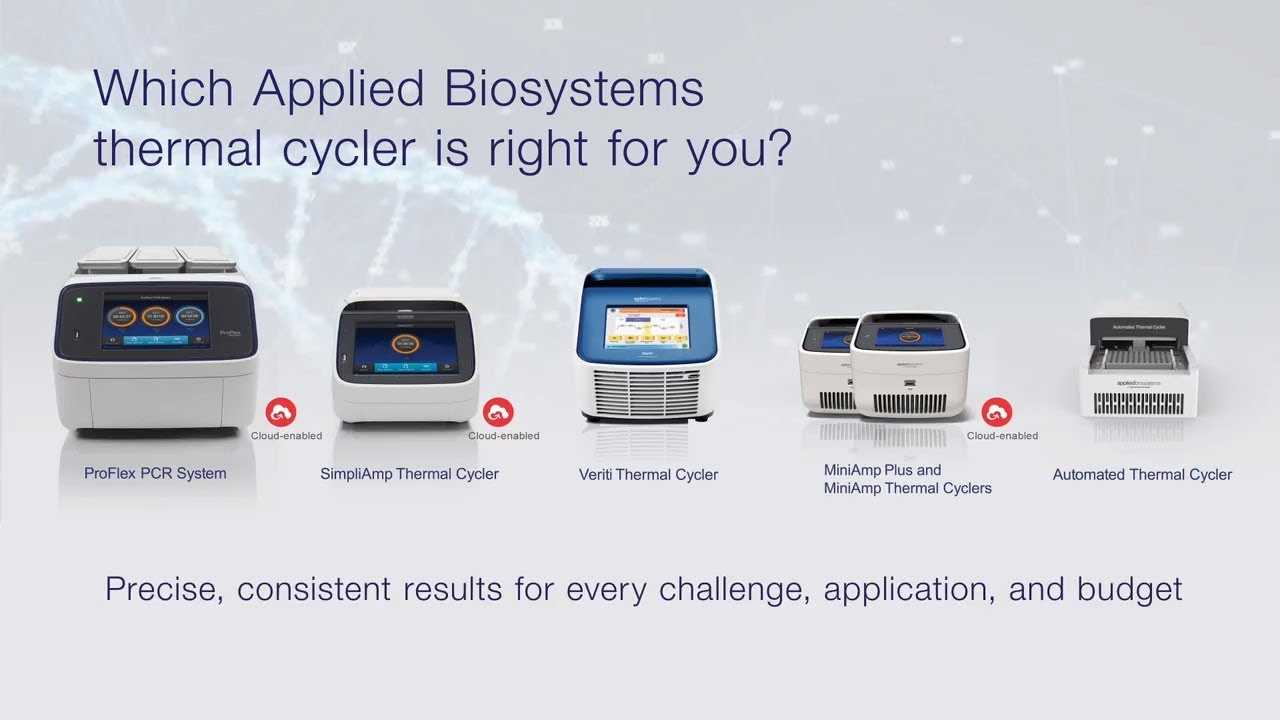
Because thermal cyclers rely on detectable SARS-CoV-2 virus, they can produce rapid results while testing the sample. However, the caveat is that the thermal cycler does not detect the SARS-CoV-2 virus in asymptomatic patients.
This is especially dangerous if the asymptomatic COVID-19 patient has recovered. Because the PCR thermocyclers testing does not identify the SARS-CoV-2 virus in such a patient, appropriate preventive measures will have been avoided, and the person can become a super spreader.
What are the Best PCR Thermocyclers?
In this section, we review the top PCR Thermocyclers for running the polymerase chain reaction.
1. Applied Biosystems 7500 ($9,999.00)
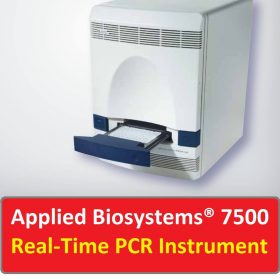
The 7500 series of PCR thermal cycler from Applied Biosystems is among the top devices for detecting the SARS-CoV-2 virus. The 5-color fluorescence signal system is undeniably among its best features. In addition, the 7500 thermal cyclers come with a 96-well format that makes setting up effortless even without automation.
Another great feature in the 7500 thermal cyclers is the provision to accommodate tube strips. This allows the technician to cap the pipettes immediately after filling them with samples and speeds up the entire process. The high-resolution melting analysis is also a feature that is indispensable in the PCR.
Applied Biosystems 7500 series is available in three models – 7500 Fast RT PCR System, 7500 Fast Dx RT PCR System, and 7500 RT PCR System. There are a few differences in features between the three models, but each yields speedy results. In addition, the three PCR models in the 7500 series come with either a laptop or a tower computer kit.
2. SimpliAmp Thermal Cycler ($2,250.00)
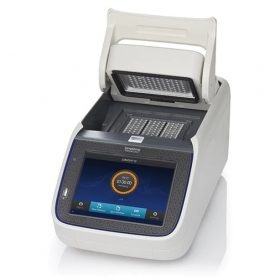
SimpliAmp is another thermal cycler from Applied Biosystems. This thermal cycler is one of the most compact ones on the market currently. But despite its small size, it runs with precision and enables accurate optimization.
One of the outstanding features of the SimpliAmp thermal cycler is the large and intuitive touchscreen. It enables simulation modes and makes programming very easy.
Simulation modes in a thermal cycler are a beneficial feature if you want to transition from an existing or older thermal cycler to the new one, such as the SimpliAmp.
SimpliAmp does not come with a computer. However, the thermal cycler can be hooked up to a desktop or a laptop through digital programs.
3. ProFlex PCR System ($5,640.00)
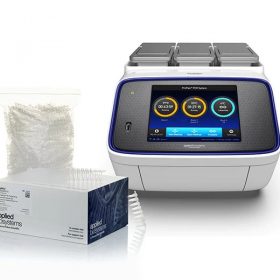
ProFlex PCR System is another thermal cycler from Applied Biosystems. It has a compact design but is packed with top features.
The five interchangeable block formats are among its best features, as you can run three experiments concurrently.
Another great feature of the ProFlex PCR System is the ease of interchanging the blocks at the flick of a switch. The dual block setting with 96-well and 384-well is another feature that yields high sequencing outputs.
ProFlex PCR System does not come with a computer but is compatible with computers and smartphones.
4. LightCycler 480
The LightCycler 480 is a high-performance PCR thermal cycler. It is among the most versatile thermal cycler where you can perform medium and high throughput reactions.
The thermal cycler also supports mono as well multicolored tests, which is an outstanding feature. Furthermore, the 96-well and 384-well block settings allow multiple plate analysis with the greatest ease. In addition, the LightCycler 480 comes with a wide set of probes and provisions for fluorescent dyes.
5. Abbott ID NOW
ID NOW from Abbott is viral for its quick results. Depending on the tested sample, ID NOW can produce the results in less than 13 minutes, which is a great achievement. ID NOW was formerly called Alere-i.
This Abbott device is also very portable and indispensable in the rapid testing of COVID-19, especially in the US. Some of the top features of ID NOW are bi-directional connectivity, QC Lockout, and near-patient testing. Near-patient testing not only reduces testing and healthcare costs but also makes this device one of the best molecular point-of-care platforms for COVID-19 testing.
6. Cobas Liat ($8,900.00)
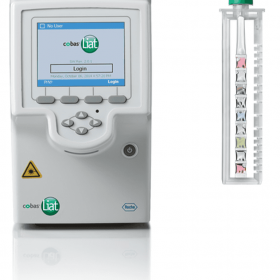
With a compact and portable design, Cobas Liat is a premium solution for many healthcare facilities. In addition to the compact design, Cobas Liat also yields rapid results making it a perfect PCR point of care solution for COVID-19 detection.
Apart from its compact design and portability, it takes about 20 minutes or less to get the test results from Cobas Liat. In addition, the results of the SARS-CoV-2 test are also very high inaccuracy that facilities testing for clinics and satellite locations.
Other features of the Cobas Liat that are worth mentioning are fully automated operation and intuitive user interface. In addition to the SARS-CoV-2 virus, this PCR solution is ideal for testing other respiratory infections such as influenza with high accuracy.
7. Bio Rad C1000 ($2,490.00)
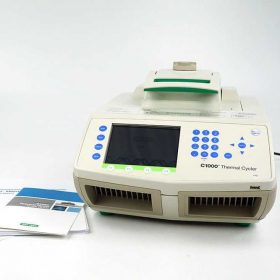
The large touchscreen of Bio Rad C1000 is what stands out at first glance. The touchscreen makes navigation and protocol editing straightforward. This modular PCR platform offers superior performance for SARS-CoV-2 virus testing.
The interchangeable reactions module that swaps effortlessly without any tools is one of its best features. Another great feature of Bio Rad C1000 is the protocol programming that produces ultrafast protocols.
This flexible modular PCR thermal cycler can hook up to other cyclers or computers to increase throughput.
8. Rotor-Gene Q 6 plex machine ($14,500.00)

The 6 plex machine from the Rotor-Gene Q is one of the real-time PCR machines in the series. The 6 represents the six channels – green, blue, red, orange, crimson, and yellow. The numbers in the other machines correspond to the channels as well.
The 6 plex machine has top features, including high optical range and rotary formats that enhance optical and thermal performance. In addition, the software in the Rotor-Gene Q 6 plex machine is user-friendly, which makes operating it very effortless.
9. Quidel Sofia 2 ($1,390.00)

Sofia 2 from Quidel is one of the quickest analyzers on the market. The machine delivers the SARS-CoV-2 virus test results within three minutes, which is impressive. In this regard, Sofia 2 is a great option for testing several samples to detect the SARS-CoV-2 virus.
The features of this molecular diagnostics machine include flexible workflow, customizable settings, and barcode technology. The interface of this analyzer is also very user-friendly, which makes PCR effortless.
10. Afinion 2 ($2,095.00)

Afinion 2 is another compact analyzer from Abbott. The cartridges of this analyzer are the star of the machine as it is engineered to deliver accurate results. This analyzer also comes with self-check systems that work in conjunction with error detection to keep errors minimal.
This Abbott analyzer is also one of those systems that can seamlessly perform multiple analyses at once. The Afinion 2 was originally introduced to test diabetes. However, this FDA-approved analyzer is also capable of running other tests with the same efficiency.
11. StepOnePlus Real-Time PCR System ($8,999.00)

This real-time PCR system comes with instrumentation and advanced software. In addition, it also has a 4-color optical LED recording system that is highly sensitive. The data analysis of this PCR system is also very intuitive.
Another great feature about this PCR system is the software that is intuitive as well as robust. This real-time PCR system is also ready to use out of the box, making it a perfect machine for first-time users.
The 96-well system on this real-time PCR delivers quick results. In addition, this setup also makes it possible for the system to run the data independent of a plate setup or a computer.
12. Eppendorf Mastercycler ($6,999.00)
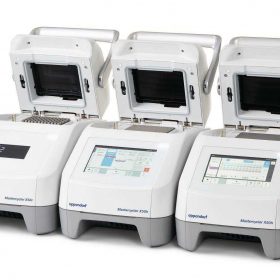
We can find several PCR machines from different reputed brands. These machines come with different requirements and serve the desired purposes effectively. One such machine in the market at present is the Eppendorf Mastercycler PCR machine. Phenomenal efficiency paired with incredible technology is what the Eppendorf machines are made of. Read to know more about these machines and their uses.
Specifications:
The following specifications are found in the Eppendorf Mastercycler PCR machines.
- Size/Dimensions – 33 x 43 x 27.5 cm
- Wells – 96 or 384
- Heating technology – Six Peltier elements
- Temperature Range – 4-99 degrees
- Gradient Range – 1-30 degrees
- Interface – USB and Ethernet
- Weight – 10.7-11.5 kg
Features:
The Eppendorf Mastercycler PCR machines are available in different models. The most prevalent one is the X50 series. The 5333 machine is another prevalent one. All the Mastercycler PCR machines come from Eppendorf and provide numerous features. Some intriguing ones are as follows:
- These machines come inbuilt with fast PCR consumable options like advanced software controls and excellent touchscreen technology.
- These machines provide a heating range of up to 5 degrees centigrade.
- The PCR operators can switch between wide block selections from a 384 block to a fast silver block.
- Its 2D gradient is another innovative addition that provides advanced optimizations techniques of the PCR machines.
- This machines’ touchscreen is capable of controlling up to 9 other units.
- These machines allow the users to transfer all the programs with constant parameters from different cycler models.
- Mastercycler PCR machines can transfer the data through a USB connection or by connecting the PC through a LAN (ethernet).
Advantages:
As mentioned above, Eppendorf manufactures different Mastercycler PCR machines based on the purpose and technology requirements. So, these machines offer a wide range of benefits to their users. Some prevalent benefits from these machines are discussed below.
- Multiple Functionality:
Most Mastercycler machines work for different applications like PCR optimization, Incubation, Standard PCRs, Cycle Sequencing, and Fast PCRs.
- Advanced Applications:
These machines provide advanced PCR techniques like the 2D gradient function that saves the optimization time for a PCR, Gradient Control-target applications, troubleshooting amplification issues, etc.
- Ergonomics:
These machines come with improved ergonomics and are designed to provide rapid yet accurate results on every usage.
- Efficient Functionality:
Mastercycler PCR machines add a flexible and intuitive solution to research documentation and tracking the data. Their systems provide enhanced efficiency in documentation, organizing, finding, and achieving the collected data.
- Heating and Cooling Techniques:
Mastercycler machines from Eppendorf are incorporated with faster heating and cooling techniques. The heating rate for these machines is around 10 degrees per second, and the cooling rate stands at 5 degrees per second. Another intriguing advantage of these machines is, the lid height automatically adjusts itself based on the requirement.
- PCR Optimization:
As mentioned above, these machines have an additional 2D gradient feature. This feature is the Denaturation temperature gradient (by row) and Annealing temperature gradient (by column). These act together to improve the overall optimization of the PCR machines.
The Mastercycler from Eppendorf is a thermal cycler that is a class apart. It comes with the proprietary CycleManager X50 Software, allowing technicians to monitor up to 50 cyclers through a central server. In this regard, this PCR thermal cycler sets a new yardstick in terms of speed and productivity.
Another outstanding feature of the Mastercycler is the ease at which it heats and cools. The heating rate is about 10oC without compromising the homogeneity in the reproducibility.
The level of optimization with the Mastercycler is also top-notch. With up to 96 reaction parameters in place, it can execute two PCR steps in one go.
13. LightCycler 96 Real-Time PCR System
The LightCycler 96 is another compact PCR system that delivers quick results. This thermal cycler has a 96-well system with fiber optic software that enables data capture and precision thermocycling.
The gradient functions also facilitate the delivery of accurate results of COVID-19 virus testing. In addition, temperature calibration is also straightforward in this thermocycler. Furthermore, the machine also delivers quick and accurate results without the need for referencing passive dyes.
The LightCycler 96 has an intuitive touchscreen that enables easy analysis of data. Lab technicians can also choose between the connectivity options – a USB stick or a network.
14. Qiagen QIAcube
The QIAcube from Qiagen is a classic thermocycler from the Qiagen group. The spin columns of this machine are quite extraordinary and deliver almost instant results. In this way, the QIAcube eliminates manual work to a large degree.
QIAcube’s other great feature is running up to 12 samples per run, accelerating productivity. The touchscreen of this thermocycler is a transmissive TFT with high brightness and is very user-friendly. Besides, the Qiagen software preinstalled in the thermocycler and automated processing also makes the entire process effortless.
Conclusion
The battle with COVID-19 is far from over, and many parts of the globe continue to fight against the virus. PCR Thermocyclers has played a pivotal role in detecting the SARS-CoV-2 virus in labs, clinics, hospitals, and even satellite locations.
Thermal cyclers reduce manual work, expedite the testing process, and make it convenient to test bulk COVID-19 samples at once. On top of it all, PCR thermal cyclers deliver the most accurate results in detecting the SARS-CoV-2 virus, which is now the preferred method for labs and test agencies worldwide.
